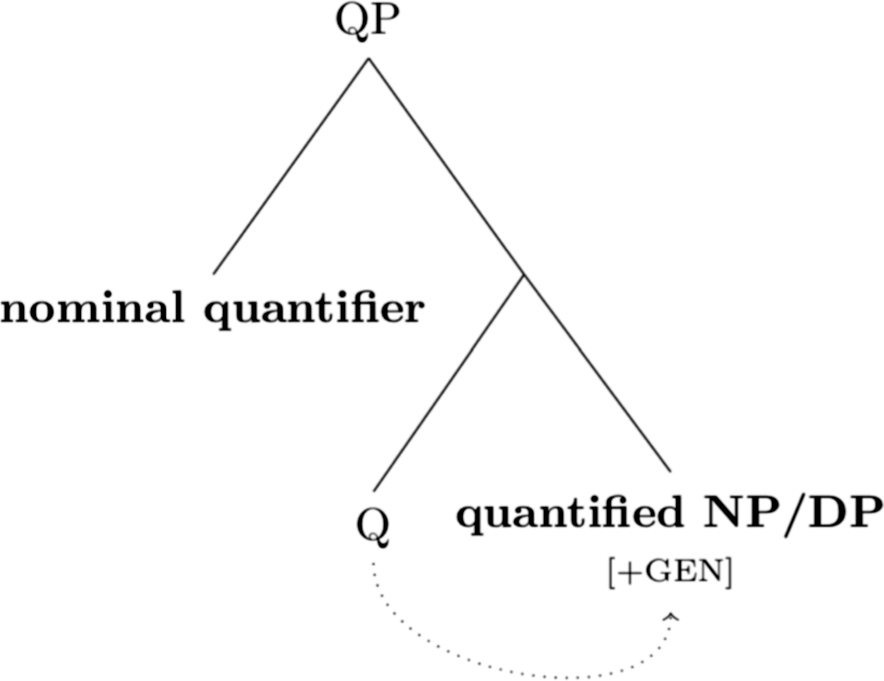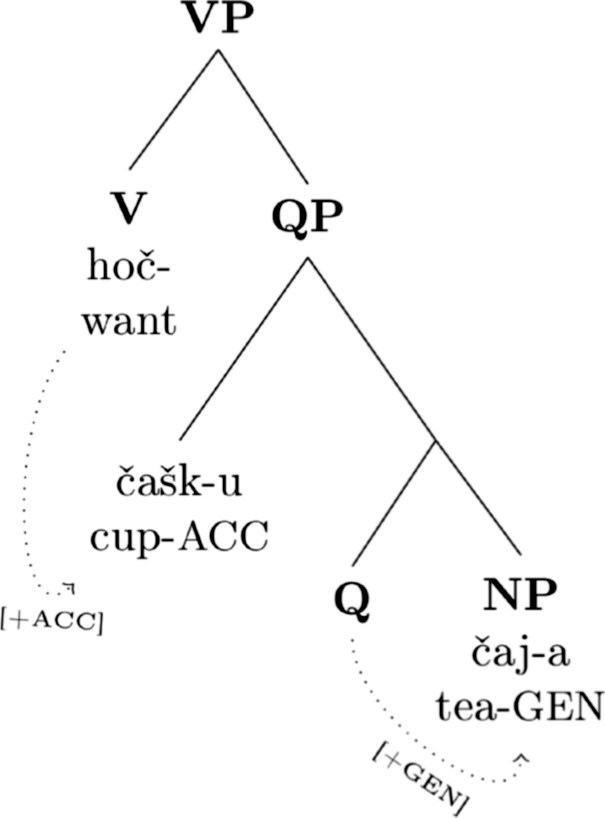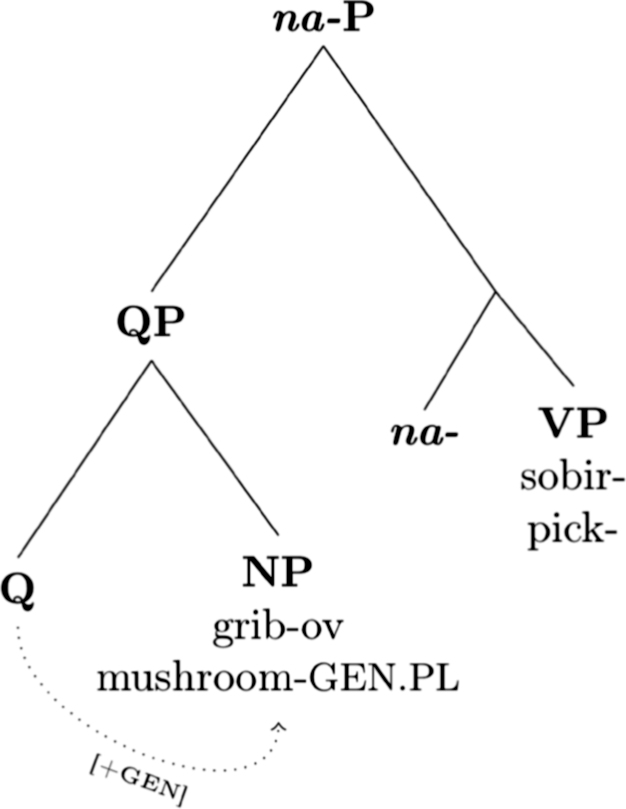Slavic Languages in the Perspective of Formal Grammar
Proceedings of FDSL 10.5, Brno 2014
Summary
Excerpt
Table Of Contents
- Cover
- Title
- Copyright
- About the author(s)/editor(s)
- About the book
- This eBook can be cited
- Contents
- Nominal Partitive Constructions in Russian
- Semantic Analysis of Czech Demonstrative Pronoun TO
- Accounting for Agreement Patterns in Coordinate Noun Phrases with a Shared Modifier
- On (Non-)Compositionality of Prefixed Verbs
- Deducing the Generalized XP Constraint from Phasal Spell-out
- On the Semantics of the NP-Internal Word Order: Chinese vs Serbo-Croatian
- Rule-Based Person Named Entity Recognition for Bulgarian
- Why is Distributivity So Hard? New Evidence from Distributive Markers and Licensors in Czech
- The Underlying Representation of the Russian Suffix -ɨva
- Development of Word Order of Preterit Auxiliary Clitics in the Old Czech Bibles
- Wh-in Situ in a Multiple Wh-fronting Language
- Gender Impoverishment in Czech, Slavic, and beyond
- Genitive in Contemporary Czech from the Perspective of Morphological Tagging and Parsing
- Participle Passives and Passive Participles in Russian: Aspect
- Possible and Impossible Cases of Possessive Perfect
- Expressive Morphology in Russian and Other Languages
- The Story of Polish Para
- On delayed Transfer and a Nano-syntax inspired Account of Genitive of Quantification
| 9 →
Lomonosov Moscow State University
Nominal Partitive Constructions in Russian1
Abstract In this paper we will discuss the nature of Russian nominal quantifiers. Also we will provide a syntactic analysis for nominal partitive constructions (NPC, ‘čaška čaja’ a cup of tea) that will help to unify both sources of Genitive on the quantified in the NPC and on complements of some verbs (‘vypit čaja’ to drink some tea).
1. Introduction
1.1 Theoretical background
The two main analyses of Russian Nominal Partitive Constructions are proposed by G. Rappaport (2000) and J. Bailyn (2012).
Rappaport (2000) assumes that NPC is just a case of construction formed by two nominals, such as ‘kollekcija monet’ a collection of coins, where the second noun is the complement of the first, and the source of Genitive is the position of the quantified NP, i.e. Comp-of-N.
In the view of J. Bailyn (2012) in NPCs there is a QP between two nominal projections. Also there is a class of verbs (so-called [+Qu] verbs, including na-verbs, intensional verbs, etc.) that take QPs as their object. Genitive appears because the head Q assigns it to its complement.
In both views the nominal quantifier is considered the head of the nominal projection. These solutions raise the following question: if the nominal quantifier phrase is either NP or DP then why is its interpretation as a physical object impossible (1)? ← 9 | 10 →
| (1) | *spletёnnaja | včera | master-ic-ami | KORZINA | grib-ov |
| weaved | yesterday | craftsperson-FEM-PL.INSTR | basket | mushroom-PL.GEN | |
| Expected: ‘the BASKET weaved yesterday by craftswomen filled with mushrooms’ | |||||
1.2 The goal of this paper
In this paper we will investigate Russian NPCs and nominal quantifiers that can be found in nominal partitive constructions (2). NPC are formed by two nouns: the first one is the quantifier and the second one is a quantified NP marked by Genitive.
| (2) | a. | stakan | vod-y |
| glass | water-GEN | ||
| ‘a glass of water’ | |||
| b. | korobka | konfet | |
| box | sweet.PL.GEN | ||
| ‘a box of sweets’ | |||
Further we will argue for the following points: first, it would be improper to consider a nominal quantifieras a noun of the category N such as given in (3). Second, the nominal quantifier is located in the specifier of the projection with quantificational properties (QP). Third, the source of Genitive on the quantified element of the NPC and on complements of some verbs (4) is the same head Q.
| (3) | ja | razbil | STAKAN |
| I | broke | glass.ACC | |
| ‘I broke the glass.’ | |||
| (4) | on | vypil | VOD-Y |
| he | drank | water-GEN | |
| ‘He drank (some) water.’ | |||
2. Data
In this section we will briefly discuss properties of Russian NPCs. ← 10 | 11 →
I. The nominal quantifier cannot refer to a physical object; it denotes a unit of measure
Nominal quantifier can never refer to a physical object2, therefore it cannot be modified with a low adjective specifying its shape or color (5), restrictive relative clause (6) or referential possessor (7).3
| (5) | a. | *vysokij | STAKAN | vod-y |
| tall | glass | water-GEN | ||
| b. | *krasnaja | ČAŠKA | čaj-a | |
| red | cup | tea-GEN |
| (6) | *spletёnnaja | včera | master-ic-ami | KORZINA | grib-ov |
| weaved | yesterday | craftsperson-FEM-PL.INSTR | basket | mushroom-PL.GEN | |
| Expected: ‘the BASKET weaved yesterday by craftswomen filled with mushrooms’ | |||||
| (7) | *an-in-a | KORZINA | moj-ix | grib-ov |
| Ann-GEN-FEM | basket | my-GEN.PL | mushroom-PL.GEN |
II. It is possible to modify the nominal quantifier independently of the quantified NP
Hovewer, as a unit of measure a nominal quantifier can be modified with adjectives specifying its size (8), so independent modification is allowed.
| (8) | bol’š-oj | STAKAN | vody |
| big | glass | water-GEN | |
| ‘a big glass of water’ | |||
III. For NPC the only possible object position is one of the [+Qu] verb. Even when located in this position nominal quantifier receives no Genitive
Quantifier of NPC located in the object position can be either overt (9a) or covert (9b). Note that the nominal quantifier receives no Genitive marking (9c). If NPC ← 11 | 12 → stays in the object position of [-Qu] verb, it is either interpreted as collocation (10a) or considered totally ungrammatical (10b).
| (9) | a. | on | vypil | stakan | vod-y |
| he | drank | glass.ACC | water-GEN | ||
| ‘He drank a glass of water.’ | |||||
| b. | on | vypil | vod-y | ||
| he | drank | water-GEN | |||
| ‘He drank some water.’ | |||||
| c. | *on | vypil | stakan-a | vod-y | |
| he | drank | glass-GEN | water-GEN | ||
| (10) | a. | ?andrej | uvidel | korobk-u | konfet |
| Andrew | saw | box-ACC | sweet.GEN.PL | ||
| ‘Andrew saw a box of sweets (= a box with sweets).’ | |||||
| b. | #on | razbil | bokal | vin-a | |
| he | broke | glass.ACC | wine-GEN | ||
| Expected: ‘He broke a glass of wine.’ | |||||
There is no restriction on the size (11) or referentiality (12) of the quantified NP4. The only requirement is that only non-referent NPs could be marked by Partitive Genitive5 (12).
| (11) | bokal | tvo-ego | prekrasn-ogo | bel-ogo | vin-a |
| glass | your-NEUT.SG.GEN | excellent-NEUT.SG.GEN | white-NEUT.SG.GEN | wine-GEN | |
| ‘a glass of your excellent white wine’ | |||||
| (12) | a. | čaška | kuplennogo | včera | čaj-a | / | *čaj-u | ||
| cup | bought | yesterday | tea-GEN | / | tea-PART | ||||
| ‘the cup of TEA that was bought yesterday’ | |||||||||
| b. | každyj | den’ | on | vypivajet | čašku | čaj-a | / | čaj-u | |
| every | day | he | drinks | cup | tea-GEN | / | tea-PART | ||
| ‘Every day he drinks a cup of tea.’ ← 12 | 13 → | |||||||||
The correspondence between the nominal quantifier and quantified NP is semantically restricted (13), see discussion of the s-selection in partitive contexts in Borschev (2014).
| (13) | a. | baton | xleb-a |
| loaf | bread-GEN | ||
| ‘long loaf’ | |||
| b. | #stakan | xleb-a | |
| glass | bread-GEN | ||
| ‘a glass of bread’ | |||
3. Summary of relevant properties
An appropriate analysis for Russian nominal partitive constructions must take into account following problems:
(i) Impossibility of referring to a nominal quantifier as to a physical object;
(ii) Possibility of separate modification of the nominal quantifier;
(iii) The source of Genitive case on the quantified NP both in the presence of a nominal quantifier and in its absence.
4. Analysis
I agree with Bailyn (2012) in the existence of the QP projection, where the head Q assigns Genitive to its complement. Since the nominal quantifier cannot be interpreted as a physical object, is not marked Genitive and can be independently modified, we suggest that it is located in the specifier of the QP projection. Figure 1 reductively shows the structure of the nominal partitive construction in Russian.
All the properties listed above in the “Data” section are accounted by this analysis.
The location of the nominal quantifier within the functional projection predicts the impossibility of interpreting the quantifier as a physical object, explaining asterisk on (1).
A nominal quantifier can be modified independently of the quantified NP (8), because it is located in the specifier position that, according to Jackendoff (1977), can only be occupied by constituents. Also this analysis applies no structural restrictions on the size of the quantified NP.
The source of Genitive on the quantified complement of the NPC and on the quantified object of [+Qu] verbs is the same, i.e. head Q assigns it to its complement, so there is no need in distinguishing between these two cases. Moreover, ← 13 | 14 → the observation that the only possible object position that can be occupied by NPC is that of the [+Qu] verb, becomes not only unsurprising, but rather inferred logically. Likewise, the nominal quantifier located in the object position of the [+Qu] verb is not marked Genitive, because it stays within the QP projection, but not below it.
Figure 1: Nominal Partitive Construction

Two partial diagrams below illustrate NPC with an overt nominal quantifier in the object position of intensional verb (Figure 2, example 14) and quantified NP without overt quantifier in the object position of na-verb (Figure 3, example 15). Here we accept the version of analysis in which head V assigns gccusative case to its complement Wurmbrand (2006), Pesetsky & Torrego (2011) i.a. and Pereltsvaig’s (2006) analysis of na-construction, for details see below.
| (14) | andrej | xochet | čašk-u | čaj-a |
| Andrew | wants | cup-ACC | tea-GEN | |
| ‘Andrew wants a cup of tea.’ | ||||
| (15) | maša | na-sobirala | grib-ov |
| Mary | na-picked | mushroom-PL.GEN | |
| ‘Mary picked (a lot of) mushrooms.’ ← 14 | 15 → | |||
Figure 2: NPC with overt nominal quantifier in the object position of intensional verb

Figure 3: quantified NP without overt quantifier in the object position of na-verb

5. Related constructions with Genitive of Quantification
The same quantificational projection QP is involved to explain source of Genitive on the quantified NPs in other constructions with Genitive of Quantification (GQ constructions) as well. Some of them are given below.
5.1 Numerals assigning Genitive case
Some numerals in Russian can assign Genitive case (16). Bošković (2006) proposes an analysis in which they “project a QP taking NP as their complement, which they case-mark, on a par with case-assigning verbs and prepositions” Bošković (2006: 102).
| (16) | ivan | kupil | pjat’ | mašin | Bošković (2006: 1) |
| Ivan | bought | five.ACC | car.GEN.PL | ||
| ‘Ivan bought five cars.’ ← 15 | 16 → | |||||
5.2 Quantifiers assigning Genitive case
Complements of some Russian quantifiers appear in Genitive as well (17). Madariaga (2007) believes such quantifiers to be located within the quantificational phrase with the head Q assigning Genitive to its complement.
| (17) | mnogo | det-ej | opozdalo | Madariaga (2007: 1) |
| many | children-GEN | arrived.late | ||
| ‘Many children arrived late.’ | ||||
5.3 Cumulative na-verbs
A topic of numerous investigations in Russian syntax is na-verbs, whose complement always appears with Genitive marking (18).
| (18) | na-rvatj | cvet-ov | Romanova (2007: 176) |
| NA-pick | flowers-GEN.PL | ||
| ‘to pick (a lot of) flowers’ | |||
Three main analyses of na-verbs are presented in Romanova (2007), Pereltsvaig (2006) and Tatevosov (2008). Romanova (2007) supposes that na- represents a VP-external quantifier over events that indirectly quantifies (Quantification at a Distance, QAD) over the internal argument. Quantificational phrase QP is located above na-P. Nominal projection stays below VP, but it is not being introduced by the prefix. On the contrary, Pereltsvaig (2006) considers prefix na- as an argument-introducing element that brings QP in derivation, head Q of which assigns Genitive to its complement (cf. Piñón’s (1994) analysis where na- itself appears as Genitive assigner). From syntactic point of view Tatevosov (2008) modifies Pereltsvaig’s analysis in the location of the na-P: he assumes it to be a vP-dominating superlexical prefix.
6. Conclusion
In this paper we briefly describe the main peculiarities of nominal partitive constructions in Russian and propose a possible explanation of their structure. In our analysis we accept Bailyn’s (2012) concept of the existence of QP projection with head Q assigning Genitive, but with the following modification: nominal quantifier must be located within the QP or, more precisely, in the spec-QP. This specification helps us to cope with the impossibility of interpreting the nominal quantifier as a physical object. Sententially NPCs can appear in the object position of [+Qu] verbs, in the latter case nominal quantifier is assigned Accusative and the quantified complement remains marked Genitive. ← 16 | 17 →
List of abbreviations
ACC – Accusative, FEM – feminine, GEN – Genitive, INSTR – Instrumental, MASC – macsuline, NA – the productive cumulative verbal prefix na-, NEUT – neuter, PART – Partitive, PL – plural, SG – singular.
References
Bailyn, John F. 2012. The Syntax of Russian. Cambridge University Press.
Bošković, Željko. 2006. Chapter 4. Case and Agreement with Genitive of Quantification in Russian. In C. Boeckx (ed.), Agreement Systems. John Benjamins Publishing. 99–120.
Borschev, Vladimir B. 2014. Ob integratsii formalnoj i leksicheskoj semantiki. Handout from FARL 2014.
Jackendoff, Ray. 1977. X’ Syntax: A Study of Phrase Structure. Cambridge, MA: MIT Press.
Madariaga, Nerea. 2007. Russian Patterns of Floating Quantification: (Non-)Agreeing Quantifiers. In P. Kosta & L. Schürcks (eds.), Linguistic Investigations into Formal Description of Slavic Languages (Potsdam Linguistic Investigations). Peter Lang: Frankfurt am Main. 267–281.
Pereltsvaig, Asya. 2006. Small Nominals. Natural Language & Linguistic Theory 24. 433–500.
Pesetsky, David & Esther Torrego. 2011. Case. In C. Boeckx (ed.), The Oxford Handbook of Linguistic Minimalism. Oxford: Oxford University Press. 52–72.
Details
- Pages
- 364
- Year
- 2015
- ISBN (PDF)
- 9783653053487
- ISBN (ePUB)
- 9783653968026
- ISBN (MOBI)
- 9783653968019
- ISBN (Hardcover)
- 9783631662519
- DOI
- 10.3726/978-3-653-05348-7
- Language
- English
- Publication date
- 2015 (August)
- Keywords
- Syntax Semantics Morphology
- Published
- Frankfurt am Main, Berlin, Bern, Bruxelles, New York, Oxford, Wien, 2015. 364 pp.

